
Featured
The Conscious Heart
On the Act of Creation and the Compassionate Teachings of Art.
Mary Anderson, Art Thou Art (In the honesty of pink and green, for Henry James), detail (1997). Courtesy Mary Anderson
By Mary Anderson
Creation is an act of love and it is perpetual.
—Simone Weil1
In 1986, as a graduate student at the School of Visual Arts, I had the privilege of dialogue with several established visual artists, among them, Jackie Winsor, Michael Singer, and William Tucker. A recent arrival to New York City, I had just settled into my studio on West 21st Street and was beginning to sketch in space, feeling my way into form with a series of freestanding studies in cardboard. One particular sculpture remains in my mind. It consisted of two sheets of cardboard, each four feet high and standing on edge, one plane supporting the other. At the top edge of the front sheet I had made a vertical cut, slicing into the rectangle, part way, to create a curve in what was otherwise a flat plane. My aesthetic intention was to soften the cardboard’s rigidity, to transform its flatness into a rounded slope, alluding more to a body than a board. The formal result of my effort was neither a flat plane nor a curve but an awkward compromise—something bent, fraught with injury and metaphor, appearing to be what it innately was not. On seeing this work during a weekly studio visit, Michael Singer responded, “These things happen in life.”
Indeed, such things do happen in life, and not only in cardboard. At the time I did not grasp the plain truth of Michael’s words in their full dimension and weight. I was instead moved by their beauty, their imminent sensibility that traced an integral correspondence between life and art. Sounding a taproot within me, Michael’s words affirmed a gnosis, an intimate knowing within me that, paradoxically, I did not yet have knowledge of. In his response I intuitively recognized a truth and intention of art: that a simple inanimate form, wrought by human hands, would bear meaning, sensible relation, to the formless realities of human life.
In the decades since first hearing Michael’s words, I have experienced their plain truth, living into their immanent dimensions, their possibility and pathos, sublimity and weight. In the fine art of existence, I discovered, we are, at once and always, both the maker and the being made. Our living is an ongoing, relational event in which our acts, words, thoughts, are doubly generative, bearing subjective and objective effect. Like the sheet of cardboard (under the artist’s hand) we may, in the course of our making, be subjected to a vertical cut and, fraught with injury and metaphor, become innately other to ourselves. We are interstitial beings—conscious and not, awake yet asleep—whose form and words bear meaning in a shareable world, across a divide that marks us, ethically and aesthetically, for life. Not made by hands, yet moored in time and flesh, we are sentient, conscient, images in the making, continually negotiating this division within us, which is the bane and balm of a truly human life. Art and prayer—thought of here in their broadest sense as forms of dialogue—reveal and represent this ambivalent core, the very “heart” and horizon of our being and becoming human.
♦♦♦
The work of art, like the work of prayer, dialogically traces and traverses this interstitial horizon of meaning within us. Each represents what I think of as the heart, le coeur, of dialogue, instantiating the revelatory dialectic at the heart of creation, and thus, at the heart of human language and subjectivity, representation and religiosity. In prayer and in the work of art we are, consciously and not, forming and being formed, participating in a dialogue that reiterates an originary and differential act of creation. The images and words that follow are adapted from a lecture I delivered at the Center for the Study of World Religions,2 originally scheduled for April 19, 2013—the day of the Boston area lockdown in the wake of the marathon bombing. The poignant eruption of this wanton violence as I prepared to speak on the conscious heart and the act of creation was sobering. Yet rather than stalling on the incapacity of language to address such pain and brutality, I was immediately drawn to reflect on the constitutive necessity and value of representation—words, images—their stabilizing presence within our fragile, uncertain, and embodied lives.
How does one speak about cultivating a conscious heart in the face of indiscriminate acts of terror that deny life itself in the denial of the life and value of the other? Can art and its compassionate teachings offer a sensible witness, a viable response, for countering such violence, its undertow of fear and ignorance of self and other, and, more precisely, of self as the other? Is compassion for life—for the life of the other person and our own—the real, if silent, meaning that is given form, dimension, and weight in the work, the labor, of art?
I do not presume to answer these questions. What I offer here is a response—part essay, part meditation—on the nature of representation, directing our attention to the dialogical, intersubjective, and empathic nature of the creative act, particularly in the making and viewing of art and within the practice of prayer. My thought will move somewhat seamlessly and silently between words and images—of contemporary art, Byzantine iconography, religious ritual—with the intention of creating a space for meaning to arise, not solely through my verbal articulation, but through a relational reality of perceiving word and image in the present moment.
Let me explain.
♦♦♦
The icon of the Kardiotissa, silently present to us here on the page, is apparently an image, a devotional object, from Greek Orthodox Christianity. On its surface we see depicted a relation between the Virgin Mother and Child, yet, more deeply, we experience—perceptually, psychologically, corporeally—the space between the icon and ourselves. By looking at the icon we are, subjectively and objectively, brought into relation with it; its spatial proximity and distance engender within us a palpable awareness of relation. We do not simply see an object in front of our eyes but experience the space between the icon and ourselves—not myself, not the icon, but a third aspect, joining and differentiating us, holding us within an intersubjective, asymmetrical space of relation. “We never look at just one thing,” John Berger writes in Ways of Seeing; “we are always looking at the relation between things and ourselves. Our vision is continually active, continually moving, . . . constituting what is present to us as we are.”3
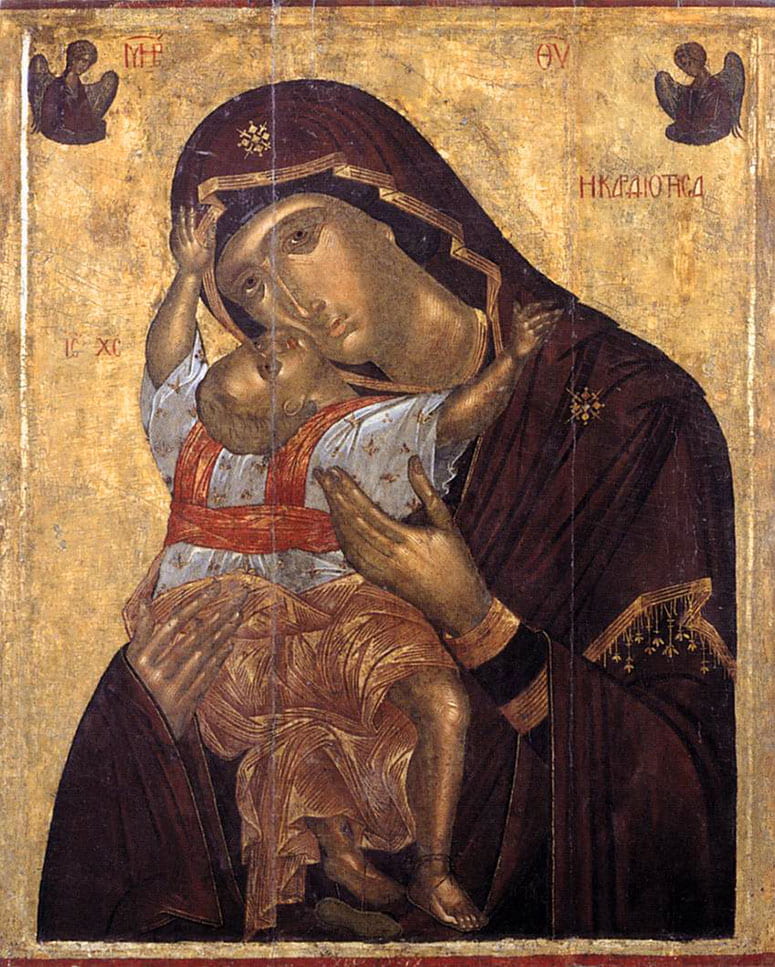
Angelos Akotantos, The Virgin Kardiotissa, icon on wood panel, 121 x 96.5 cm (first half of the fifteenth century). Exhibited in the Byzantine and Christian Museum, Athens. Wikimedia Commons. CC-PD
Written for the practice of veneration, reverence, prayer, the Kardiotissa icon heightens our awareness of the meaning, the presence, that can arise and abide within this space of relation—between the viewer and the object, the lover and the absent beloved—made present, remembered, through the alterity and difference of an image. In a theological sense, the icon configures a visible face and relation for this absent other that is considered nonvisible, or not of the order of the visible, and thereby performs the revelatory dialectic of absence and presence intrinsic to representation itself. The Kardiotissa, whose name addresses the kardía, “the heart,” of creation, formally demonstrates that our vision takes place relationally and differentially. More deeply, given its religious intention, the icon shows us that this space of relation between a viewer and an object is, can be, holy ground. As an image that is believed to be “identical [tauton] with the prototype, even though it is other, different [eteron],”4 the Kardiotissa performs and illumines the interstitial core of creation—the differential space of meaning that takes place dia-logos—through logos, language, reason, Word—between myself and an other. Art, an image, reveals and reminds us that we become present to ourselves and to the world, through our relation to the other.
Seeing an image will thus mean listening,5 attuning oneself, to this differential space of relation that incorporates a distance, the aesthetic distance necessary for authentic vision to take place. To see is not only “to have at a distance,”6 as Maurice Merleau-Ponty writes; it is to behold and be held within—even here in digital reproduction—a relational reality that is plainly before us yet is also somehow beyond and within us. “The only evidence of truth in art exists when it compels us to say, ‘I see,’ ” writes Rabindranath Tagore—the Bengali poet, visual artist, writer, and Nobel laureate (1913)—in his Religion of Man.7 To say “I see,” in English as in Greek, can also mean “I know.” Art can be an epistemological practice, a practice of coming to know, of seeing and creating (with) a conscious heart.
Meaning, in this sense, becomes a verb, a present participle, a presencing at a horizon of relation that emerges in the proximity of form to form, image to image, word to image, and all in relation to you and me—the perceiving subject. As in the practice of contemplation—from the Latin contemplari, “to gaze attentively, observe, mark out a space for observation”8—meaning arises and abides, always, in the present—a moment of relation that cannot negate or erase the discrete meanings, intentions, or authorship of a historical image or form but is instead utterly dependent upon them. The present moment of meaning that we experience aesthetically, bodily, proprioceptively, in prayer and in the work of art, holds, at once, these apparent contradictories—the contingent and the eternal, the durative and the ephemeral, the particular—and through it—the common, the communal . . . communion. In the Christian scriptural tradition, the Prologue of the Gospel of John inscribes this paradox of apparent contradictories into the life of a human being; the eternal word, logos, is born into the finitude of flesh and pitches a tent among and within us (John 1:1–18). Through this eternal word, dia-logos, all things—I and Thou, your world and mine—come into being.
♦♦♦
The work of art performs a transposition of interior to exterior grounds; it awakens, mirrors, and translates aspects of self and psyche, moving and advancing consciousness both for the artist as maker and the viewer as perceiving subject. By limning a permeable boundary between subjective and objective spheres, the work of art pierces the shallow confines of my seemingly private world, revealing my depth, my subjectivity, but also my responsibility.
A Word Made Flesh . . . Throat (1994) by the American artist Lesley Dill echoes in contemporary visual idiom the narrative of incarnation inscribed in the Prologue of St. John.11 Its words, painted on the image of a woman’s throat, are the first two verses of an Emily Dickinson poem, “I am afraid to own a Body— / I am afraid to own a Soul.” They direct our attention to the burdens of consciousness, the requisite responsibilities of owning and mindfully claiming one’s somatic existence. Implicitly, Dickinson’s poem continues: “Profound—precarious Property— / Possession, not optional—Double Estate—entailed at pleasure / Upon an unsuspecting Heir— / Duke in a moment of Deathlessness / And God, for a Frontier.”12 Thus Dill’s photo-lithographic image tacitly carries the viewer beyond its actual frame to the oscillating boundaries of the body, a precarious property bearing infinite and finite aspects. Through art, its labor and its objecthood, my singular world is inverted, turned inside out, acquiring an ethical face and existence within a world of relation. Art, its sentient, formal, and ethical intelligences, mimetically incorporates the lessons of our own conscient embodiment.
♦♦♦
Images are relational, intersubjective phenomena; they incorporate, emerge from, and are a form of dialogue. When we are present to, with or within, a work of art, it has the capacity to make us present to ourselves. Like prayer and its inwardness, art is not only an expressive event, presenting a tangible surface; it may also be a contemplative act, a practice of beholding, of resting the mind in the heart. This act of beholding is itself an act of making, an attending with the heart and the hand for the artist and viewer alike. Not solely the domain of traditional religious art and aesthetics, prayer becomes an event of orientation, of creating with an intentional and attentive heart. The artist’s capacity to work in and through and with material, bringing intention to a visible surface and form, cultivates this passionate quality of presence, an inmost attending to the work, the labor, of creation. In his compelling monograph, Devotional Cinema, the experimental filmmaker Nathaniel Dorsky testifies to this ontological sensibility of art. “I began to experience film as a direct and intimate metaphor or model for our being, a model which had the potential to be transformative, to be an evocation of spirit, and to become a form of devotion.” Film, Dorsky attests, can subvert our absorption in the temporal and expose the real measure of our being in the world. “It is,” he tells us, “alive as a devotional form.”13
In Dorsky’s words, which define devotion not within an institutional form but as an opening that “allows us to experience what is hidden, and to accept with our hearts our given situation,”14 we find an apt description of prayer. Like art, prayer is a dialogical and generative act, a beholding and a being held, in which we become present to ourselves through the other. Like prayer, art reorients “our absorption in the temporal and reveals the depths of our own reality, opening us to a fuller sense of ourselves and our world.”15 In seventeenth-century Russia, St. Dimitri of Rostov bore similar witness: “The principal thing is to stand with the mind in the heart before God,” he instructs. “Every prayer must come from the heart, and any other prayer is no prayer at all.”16 What an exquisite criterion for art, and for the creative act, that it recognizes its devotional origin and necessity. Art, as a form of prayer, teaches and attends this necessity, touching the inmost aspects of our being and our world. Might we then say that art, to be real—a real measure of our being in the world—must come from the heart, or it is not art at all?
♦♦♦
It is possible to experience art in the way martin Buber speaks about language: “The word,” he writes, “is an abyss through which the speaker strides. One should speak words as if the heavens were opened in them. And as if it were not so that you take the word in your mouth, but rather as if you entered into the word.”17 The beauty of Buber’s words is their emphasis on our intention when speaking, his recognition of the word as a sphere of relation, dia-logos, through which we come to be, within which we live and move and have our being (cf. Acts 17:28). What an extraordinary difference there is between “taking the word in your mouth” and “entering into the word.” Art offers a space to experience this difference of intention, the difference between appropriation and reception, between grasping and listening, between talking about a thing, objectifying it, and being in dialogue with it.
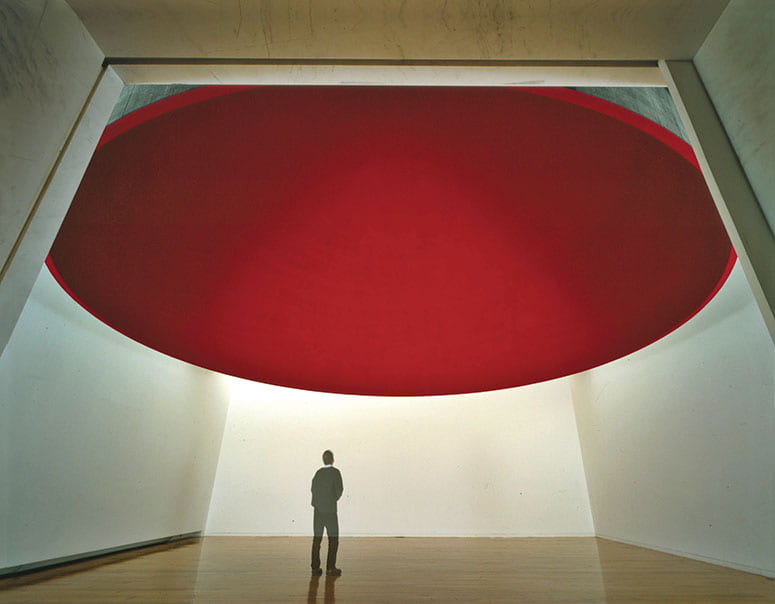
Anish Kapoor, At the Edge of the World I, fiberglass, paint, and pigment, 500 x 800 x 800 cm (1997). Anish Kapoor / courtesy Lisson Gallery, London.
Anish Kapoor’s installation, At the Edge of the World I (1997), offers us an image and bodily experience of this edge of language, what it might feel like to enter the word, being born into a differential sphere of relation, dwelling in the interstice between womb and world. In this work of art we see represented a primary sphere of relation, the priority of the mother and of language, our first experience of otherness, intersubjectivity, and dialogue, within and without. “There is language, there is art,” George Steiner writes, “because there is the other.”18 The Hebrew Bible’s Deuteronomy inscribes this priority of the other within us, using a language of embodiment and interiority: “the word is very near you, it is in your mouth and in your heart, for you to observe” (Deuteronomy 30:14).
Roni Horn’s 1992–93 How Dickinson Stayed Home19 offers another opportunity to enter the world through Emily Dickinson’s words, “My Business is Circumference.” Horn’s sculptural installation draws into one experience the volume of a room and a sentence, words made tangible so that they can be read, felt, navigated, and bumped into in space and time. Horn’s art tells us that our business is circumference as well, negotiating a sphere of relation in which words, our words and others’, matter. Words have color, edges, weight; they occupy space; they take time; they live within, among, and—amazingly—without us. A second work by Horn, Limit of the Twilight (1991–2000), affords another sense of the word wherein its meaning extends far beyond its physical size or literal reference. If we enter into—are present to—this art, we experience the incongruous coincidence of meaning that moves beyond words yet is represented within them. Horn’s title for the work recognizes these capacities and liminalities of language, distilling a seemingly infinite distance into the matter and measure of words.20
♦♦♦
An image, a work of art, can lead you through an abyss and open the heavens within you; it may receive you, meet you, stun or awaken you into being present, mindful, sensible. Through the alterity and exteriority of art—it is other than me even when it is made by me—the artist and viewer can experience a shift or alignment in their internal and external worlds, effecting an awareness of human interrelationality. The asymmetrical encounter between persons, and between a viewer and a work of art, represents a reality that the Vietnamese Zen Buddhist monk Thich Nhat Hanh has called “inter-being.” A conscious heart intends and reaches toward (what I think of as) this porous reality of the “inter-,” an ethical sphere of relation that is a differential locus of meaning, living between us as community and within us as individual human beings.
In the Christian tradition this reality of inter-being is symbolized in several ways: it is the eternal word, logos, dwelling within and among us (John 1:14); it is being born anew, of the Spirit (John 3:3); and it is the event of Christ—a constitutive calling, birthing, anointing, and ordaining of the heart that takes place within our inmost being. To become aware of this ineffable act of creation within is to be hailed, broken open, and fragilized by the other—the Beloved, pure consciousness, God, the true Self (atman), my neighbor . . . alterity in any form—and to begin walking the way of love. Art is, can be, an intentional practice that incites this waking and walking, resuscitating our sensibility, our devotion, creating within us a clean, courageous, and conscious heart.
By making us present to ourselves, the practices of art, like that of prayer, can cultivate awareness of one’s inmost heart. Hindu and Buddhist traditions symbolize this interiority with the Sanskrit word guha. Writing of the three hearts of human being—the anatomical heart, the emotional heart, and the spiritual heart, or guha—Swami Tyagananda, a Hindu monastic of the Ramakrishna Vedanta Society, describes the guha as “the center of higher consciousness, the seat of the true Self (atman).” He quotes the Katha Upanishad (2.1.12), which speaks of our difficulty in seeing the Self (atman), “because it is lodged inaccessibly deep in the cave of the heart” and obscured, clothed, by the body and the senses.21 The Vishvakarma, the single chaitya-griha (prayer hall), among the twelve Buddhist caves at Ellora, Maharashtra, India (ca. 700 CE), formally symbolizes this intimate reserve—a literal cave of the heart—in the solemn stillness of earth and stone.22 Carved out of time, labor, and solid basalt rock, the Vishvakarma immerses the viewer or praying subject within an archaic interiority, architecturally miming both the priority of the womb and the prayer’s subjective terrain.
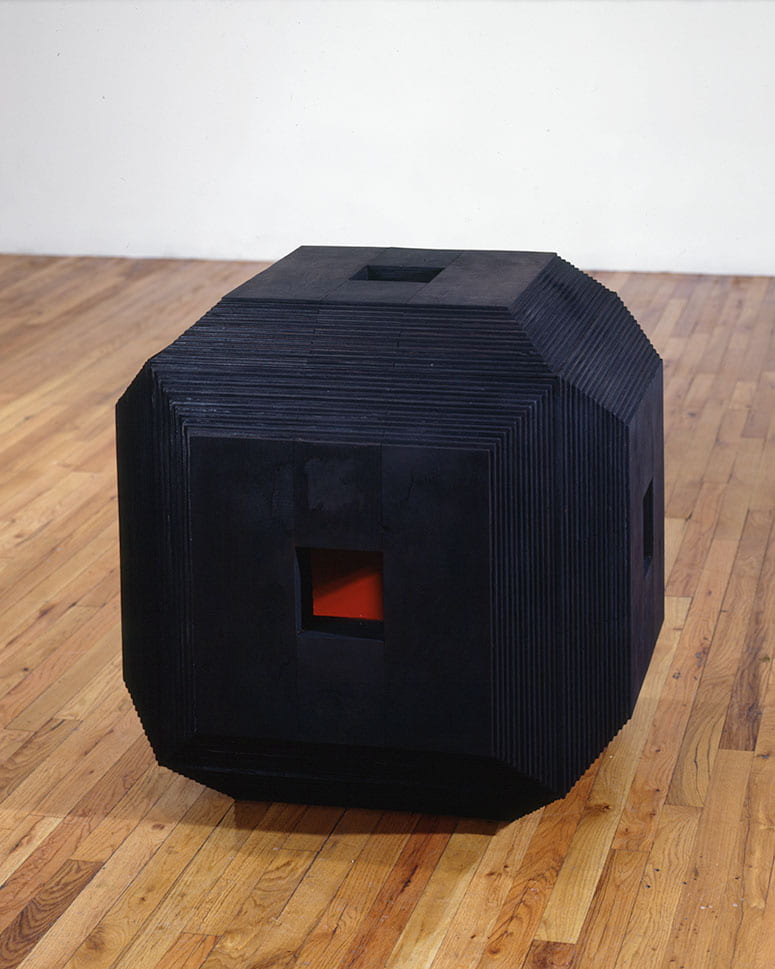
Jackie Winsor, Burned and Red Inside Out Piece, wood and paint, 30 x 30 x 30” (1985). Jackie Winsor / courtesy Paula Cooper Gallery, New York / photo by Eeva-Inkeri
Jackie Winsor’s sculpture Burned and Red Inside Out Piece (1985) represents this formal configuration of interior and exterior relations in modern, post-minimalist idiom. In this contemporary icon of dialogue and duration, accretional layers of plywood, plaster, and pigment amass into a structure that embodies and performs the existential dialectic of inwardness and outwardness, breathing relation between a still, unseen interior and an exterior, visible surface. The work’s title—a straightforward description of its physical state—nonetheless resounds the spatial, ontological inversion that takes place in the birthing of form. Winsor’s Open Cube (1983), in which the six sides of a volumetric cube open to become a flat cross, physically enacts this turning inside out, realizing, in stark metaphor, the risk involved when enclosure becomes exposure: that birth is also a death. Evocative of Orthodox double-sided icons, which depict Virgin and Child on one side of a wood panel and the Crucifixion on the other, Open Cube formally holds and signifies a coincidence of opposites, showing us that form requires, as Martin Buber affirms, both risk and sacrifice. Winsor’s Interior Sphere Piece (1985), wherein a hidden sphere inhabits the interior of a windowed cube, embodies a similar coincidence of opposites, lending volume and tangibility to the intrapsychic, archetypal ideal of squaring the circle. In its mirrored surfaces the surrounding world becomes the living skin of the form, reflecting and absorbing the external environment into itself and its continual making. In Winsor’s art one can hear and experience Tagore’s prescient words, “The consciousness of the real within me seeks for its own corroboration the touch of the Real outside me.”23 Art teaches this coincidence and permeability of subjective and objective spheres. As it instructs us in the limitations of form, it enlarges our awareness of the possibilities and responsibilities of our material embodiment.
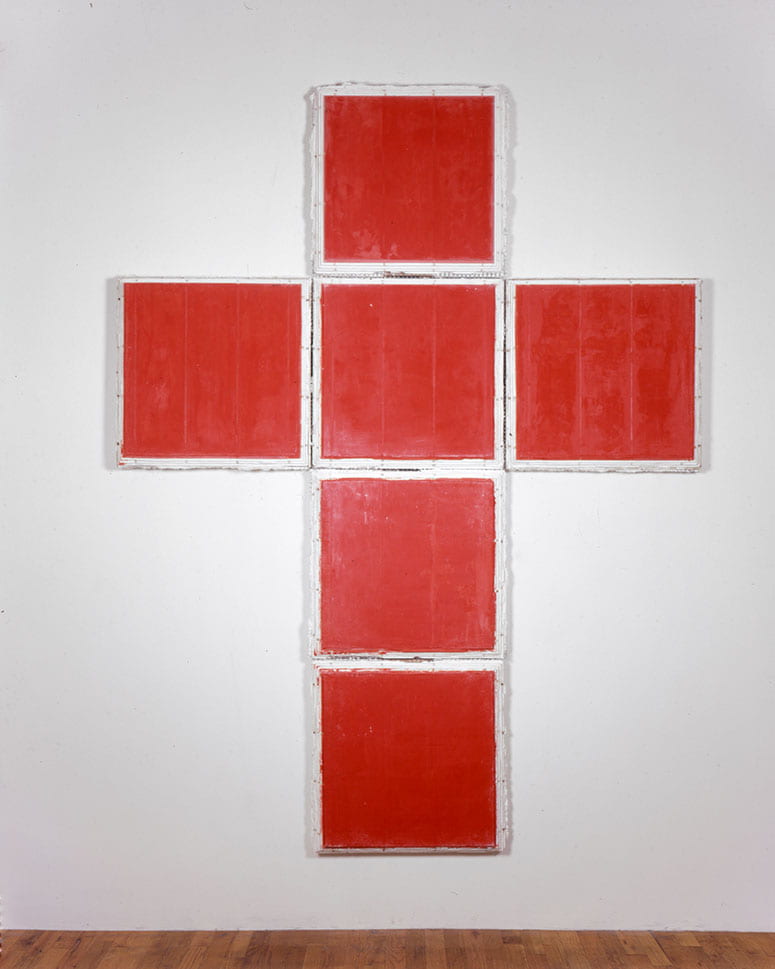
Jackie Winsor, Open Cube, plaster, pigment, wire lath, and wood, 96 x 72 x 3” (1983). Jackie Winsor / courtesy Paula Cooper Gallery, New York
♦♦♦
Contemplatives throughout the centuries have offered symbolic representation for the inmost waking to love and walking toward a conscious heart. In the Christian tradition, Teresa of Avila’s Interior Castle charts this interior and incarnational path of prayer. Through the metaphor of the silkworm she describes the initial seeding in one’s soul, the inward turn that nourishes a certainty of God’s presence, and the self-made cocoon that shelters the soul as it dies to new birth. Teresa’s resonant metaphor symbolically incorporates the mystery of the Incarnation, the way of love represented in the sacred narrative of Christianity, the life of Christ—Annunciation, Nativity/Crucifixion, Resurrection—as a human experience. The silkworm, its dying to receive life, offers a natural image for the inner formation of a conscious heart through a practice of surrender, obedience, prayer, and service. “Religious experience,” Thich Nhat Hanh writes, “is inevitably human experience. It has to do with the human consciousness, both individual and collective.”24
Art traces these movements of human consciousness, within and without, individual and collective. Like religion, art provides a form, a representational and interpretive vehicle, for that which we live through, embody, and carry within us yet often cannot see. We are, as the Katha Upanishad states, in our own way, clothed, impeded in our effort at Self-seeing. Like Winsor’s Open Cube, we need to be turned inside out. Marina Abramović’s durational performances address this desire and necessity for seeing oneself in and through the other; they envision this possibility with humor, stamina, and pathos by being in the present moment and residing in its possibility. “Performance,” Abramović states, “is about being in the present, it’s about creating a luminous state of being.”25 Abramović’s Carrying the Skeleton (2008) performs the somatic threshold of visibility, lending time and a body to the transpositioning of inside to out that we have been formally and symbolically tracing here. In this work, the core structural support of the body, its interior armature, becomes a companion to carry, a living with death, a walking labor of love and its cross. Religious experience is the experience of our humanity and its heart, le coeur, becoming conscious, incarnate, within us. These things happen in life, and art. [View Carrying the Skeleton on the MoMA website]
In my life, my art anticipated and proleptically represented these movements of consciousness and heart. In 1996, while on a Fulbright in Scotland, I created two installations in which the coincidence of birth and death, and the movement between interior and exterior grounds, was symbolized. I sited twenty cast wax busts in the graveyard of a thirteenth-century church; its four stone walls were without a roof, open to the skies. Each wax figure was placed by a gravestone that bore a woman’s name, near the base of the stone, closest to the earth, after the names of fathers, husbands, and sons. My intent in their placement was to unearth the hidden and the forgotten by giving it physical form. The work’s title, Hallowed Be Thy Name (1996),26 carried a double sense of the holy, bringing into relation the name of a human being, a woman who had lived and died, with a verse from the Lord’s Prayer. I sought to hallow this confluence of life and language, lending visible beauty to that which is between and beneath, nonvisible, not of the order of the visible, and sacred. The wax casts were first sited in the kirkyard and then within the walls of the ancient, roofless church. A year later, at the Ucross Foundation in Wyoming, I created Art Thou Art (In the honesty of pink and green, for Henry James) (1997),27 in which language visibly speaks the dialogical relation of self and other. Its repeating text moves from a question above, “Art Thou,” to a statement below, “Thou Art,” as it crosses a horizon situated at my eye level. While its palette and subtitle refer to a phrase in Henry James’s 1884 essay “The Art of Fiction,” this work’s meaning weighs the beauty and reality of belief, offering shape and voice to the formless through form, to the real through the represented. Art testifies to this interstitial horizon within, without, and between us.
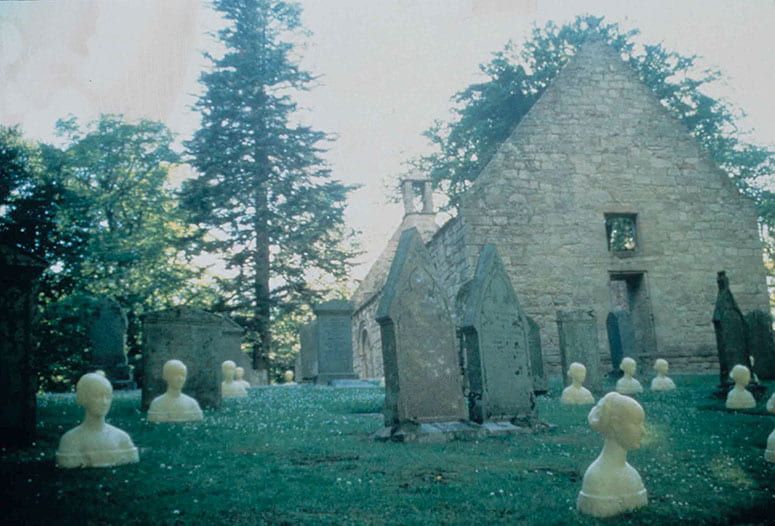
Mary Anderson, Hallowed Be Thy Name (wax, landscape, architecture, light), temporary installation in Auchindoir/St. Mary’s Parish Church, Lumsden, Aberdeenshire, Scotland (1996). Courtesy Mary Anderson
♦♦♦
Dialogue is integral to the act of creation and the work of art. Through a dialogue with the material other, the artist lends form to formlessness, at the edges of a world that is both present and absent, engaging the self and the other. John Berger’s “soon after we can see, we are aware that we can also be seen” identifies the intersubjective core of relation enacted within art and prayer. Each mediates and expresses our essential dependence upon the other, whose “eye . . . combines with our own eye to make it fully credible that we are part of the visible world.”28
The acts of making and perceiving undertaken by the artist and viewer trace this primary sense of the inter-, a space between, the intersubjective ground wherein consciousness becomes self-consciousness in relation to, and through, an other. “A person comes to feel that ‘I am the doer who does, I am the author of my acts,’ by being with another person who recognizes her acts, her feelings, her intentions, her existence, her independence,” writes Jessica Benjamin in the context of articulating a psychoanalytic theory of intersubjectivity that includes an intrapsychic concept of the self. “Recognition is the essential response,” Benjamin affirms, “the constant companion of assertion. The subject declares, ‘I am, I do’, and then waits for the response, ‘You are, you have done.’ Recognition is, thus, reflexive; it includes not only the other’s confirming response, but also how we find ourselves in that response. We recognize ourselves in the other, and we even recognize ourselves in inanimate things. . . .”29
This underlying truth of our humanity is enacted in the Hindu ritual of darśan, in which, like the Christian icon, a devotional image articulates a space of relation, a holy seeing between the devotee and deity. “It is this fact of presence which is at the basis of darśan,” writes Diana Eck. “People come to see because there is something very powerful there to see.”30 Art and prayer, in similar and different ways, provide a vantage point of alterity—an ekstasis, or “standing beside oneself”—from which we may begin to see ourselves. Through the otherness of art, its presence and its objecthood, my work and world are turned toward the other, revealed to have an ethical existence. Art confronts and affronts us; its otherness calls us, in the Levinasian sense, into question,31 initiating us to alternative ways of seeing. “Gaining this vantage point, however, . . . can be doubly disclosive. . . . [A]t the same moment that the world is given to me beyond measure, the impairment in my own vision is exposed.”32
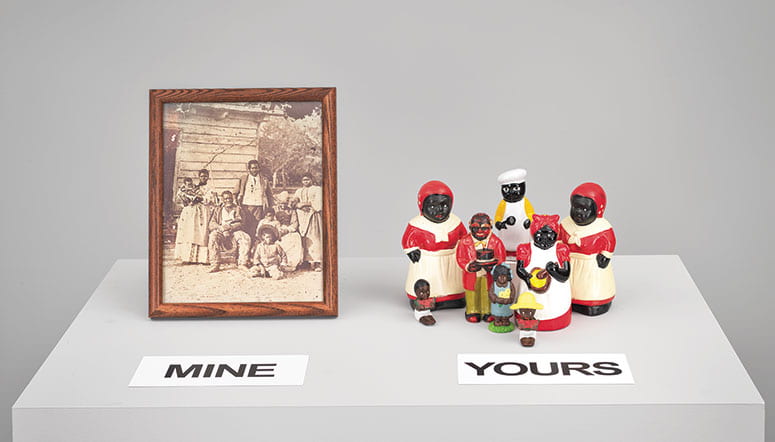
Fred Wilson, Mine/Yours, framed photograph, ceramic and plastic figures, and wood, overall (variable), 11 x 24 x 11” (1995). Whitney Museum of American Art, New York; purchased with funds from Joanne Leonhardt Cassullo, the Dorothea L. Leonhardt Foundation, Inc., and the Katherine Schmidt Shubert Purchase Fund. 96.52a-j. Digital image © Whitney Museum of American Art.
Fred Wilson’s piercing Mine/Yours (1995) provokes this double exposure of self through the other. Siting Mine—an old photograph of a rural African American family—side by side with Yours—eight stereotypic ceramic figurines of Aunt Jemima, Uncle Tom, and Little Black Sambo, two of which are eating watermelon33—Wilson’s art unveils the bias in my vision, the insidious cultural, racial, and aesthetic blinders which prevent our seeing the reality and personhood of an other. An aesthetic herald to the ethics of seeing and representing difference, Mine/Yours offers trenchant witness to the appropriative and recalibrative capacities of representation. Wilson’s installation is an incisive instance of the ethical labor of art, its jarring and agile ability to unmask and accuse our familiar modes of vision, fracturing our personal and cultural constructions of oppression. Authentic art has this revelatory capacity for exposure; it not only compels us to say, “I see,” as in Tagore’s insight, “it risks exposing the log in my own eye (cf. Matthew 7:3–4, Luke 6:41–42).”34 In this sense, the dialogical imperative of art can lead us both to caution and to compassion, demanding reflection on what human being can mean, ought to mean, and even what it, we, cannot, can never, mean.
Such intentional seeing in the practices of art and prayer will bring us face to face with the fragility of life, and belief, in our encounters with love and mortality. In his video The Quintet of the Astonished (2000),35 Bill Viola presents us with the other side of crucifixion, allowing us to stare and wonder at an unseen grief, to contemplate the aching motility of human feeling in the faces of five other people. In this work we witness the event of the others’ witnessing; their countenances present a facial topography of bereavement, shock, pain, as emotion inhabits and convulses their bodies. In muted and slowed motion, we see the affective, embodied, impress of an event absented from our view yet taking place before us, between us, in the very space in which we, the viewers, stand. Not only do we see the fragility of the other, but, by this very seeing, we are implicated in this empathic interval, as rivers of affect, unmeasured and unknown, silently pass before our eyes. In their clothed yet exposed bodies, we face our own sentience, recognize our own nakedness and vulnerability. Through this work of art’s relational interface, one experiences, glimpses, the practice of tonglen, a form of Buddhist meditation or prayer in which I exchange myself for an other, breathing in their pain and breathing out love. In Quintet of the Astonished, we bear witness to art’s differential and relational truth; we too become the astonished.
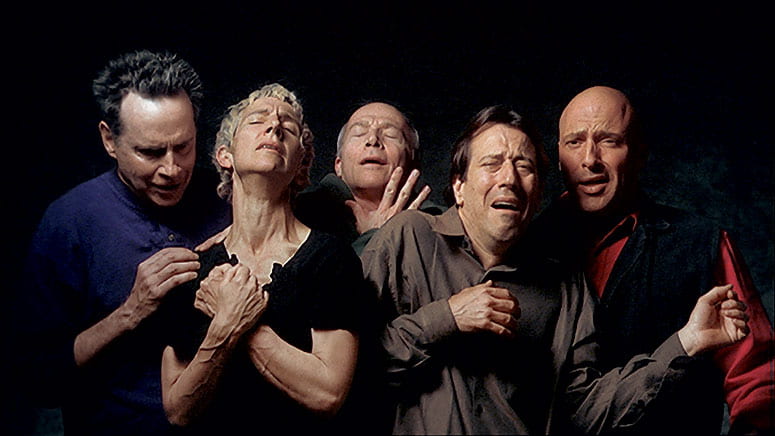
Bill Viola, The Quintet of the Astonished (2000), color video rear projection on screen mounted on wall in dark room. 15:20 minutes. Performers: John Malpede, Weba Garretson, Tomn Fitzpatrick, John Fleck, Dan Gerrity. Photo: Kira Perov.
Art that compels us to truth, to say “I see,” represents life so that we may recognize it, enter it, and receive it as our own. In art’s dialogue, with and through the alterity of the material other, the processes of art—seeing, creating, re-presenting, beholding—become ethical and empathic forms of witness that teach us to listen, to pray, to grow in compassion for life, the sentient life of my neighbor as well as my own. “Only love is capable of being aesthetically productive,” writes Mikhail Bakhtin, addressing the fact that lovelessness and indifference have no power to sustain a presence, to attend, or linger over, the work of art.36 Might we then say, or at least ponder the possibility, that compassion is the real meaning, the labor, of art?
Notes:
- Simone Weil, Gravity and Grace, trans. Arthur Wills (University of Nebraska Press, 1997), 78.
- “The Conscious Heart: On the Act of Creation and the Compassionate Teachings of Art,” September 24, 2013, Center for the Study of World Religions, Harvard Divinity School. I am grateful to Francis X. Clooney, S.J., director of the center, and to former junior fellow Leslie Hubbard for the invitation to speak as part of her lecture series, “Beyond Words: Intersections of Meditation, Visual Art, Sacred Music and Dance across Religious and Cultural Boundaries.”
- John Berger, Ways of Seeing (BBC and Penguin Books, 1972), 9.
- Gregory of Nyssa (Ep. 38, 9). See “Letter 35, To Peter . . . ,” in Anna M. Silvas, Gregory of Nyssa: The Letters (Brill, 2007), 247–256.
- Seeing, as in the Greek theoria: contemplation, a looking at, a beholding.
- Maurice Merleau-Ponty, “Eye and Mind,” in Primacy of Perception, ed. James M. Edie (Northwestern University Press, 1964), 166.
- Rabindranath Tagore, “The Artist,” in The Religion of Man (The Macmillan Company, 931), 135.
- See www.etymonline.com/index.php?term=contemplation.
- Robert Irwin, from a list of statements compiled for his 1998 exhibition at the Dia Center, 548 West 22nd Street, New York, NY.
- Ibid.
- Lesley Dill, A Word Made Flesh . . . Throat; photo-lithograph, color etching, and aquatint on tea-stained mulberry paper, hand sewn on buff wove paper, 747 x 560 mm (image/primary support);
765 x 566 mm (secondary support). - Emily Dickinson, Poem 1090, The Complete Poems of Emily Dickinson, ed. Thomas H. Johnson (Little, Brown and Company), 493–494.
- Nathaniel Dorsky, Devotional Cinema (Tuumba Press, 2005), 18.
- Ibid.
- Ibid.
- St. Dimitri of Rostov, “The Inner Closet of the Heart,” in The Art of Prayer, trans. E. Kadlaubovsky and E. M. Palmer, ed. Timothy Ware (Faber and Faber, 1997), 63.
- Martin Buber, “The Life of the Hasidim (1908),” in The Martin Buber Reader, Essential Writings, ed. Asher Biemann (Palgrave Macmillan, 2002), 80.
- George Steiner, Real Presences (University of Chicago Press, 1989), 137.
- Roni Horn, How Dickinson Stayed Home; plastic and aluminum (1993). Collection of the Museum of Modern Art.
- Roni Horn, Limit of the Twilight; solid aluminum and white plastic, 22 x 22 x 137 cm , (1991–2000).
- Swami Tyagananda, “The Heart Beyond Hearts,” in Traversing the Heart: Journeys of the Inter-Religious Imagination, ed. Richard Kearney and Eileen Rizo-Patron (Brill, 2010), 193.
- Mary Anderson, “On Seeing the Birth of the Heart,” in ibid., 418.
- Tagore, “The Artist,” 129.
- Thich Nhat Hanh, Living Buddha, Living Christ (Riverhead Books, 1995),180.
- Marina Abramović, The Artist Is Present (New York: The Museum of Modern Art, 2010), 150.
- Mary Anderson, Hallowed Be Thy Name (wax, landscape, architecture, light), temporary installation in Auchindoir/St. Mary’s Parish Church, Lumsden, Aberdeenshire, Scotland (1996).
- Mary Anderson, Art Thou Art (paint, brass wire and nails, architecture, light), temporary installation in the Marvelous Studio, Ucross Foundation, Clearmont, Wyoming (1997). I am grateful to the foundation for a one-month artist residency.
- Berger, Ways of Seeing, 9
- Jessica Benjamin, The Bonds of Love: Psychoanalysis, Feminism, and the Problem of Domination (Pantheon Books, 1988), 20–21.
- Diana L. Eck, Darśan: Seeing the Divine Image in India (Columbia University Press, 1998), 51.
- Emmanuel Levinas, “Ethics as First Philosophy,” in The Levinas Reader, ed. Seán Hand (Blackwell, 1989), 81.
- Mary Anderson, “Art and Inter-Religious Dialogue,” in The Wiley-Blackwell Companion to Inter-Religious Dialogue, ed. Catherine Cornille (Wiley-Blackwell, 2013), 100.
- Fred Wilson, Mine/Yours (1995). From the press release for an exhibition at the Frances Young Tang Teaching Museum and Art Gallery at Skidmore College, Saratoga Springs, NY.
- Anderson, “Art and Inter-Religious Dialogue,” 100.
- Bill Viola, The Quintet of the Astonished (2000) color video rear projection on screen mounted on wall in dark room; projected size 1.4 x 2.4 m, room dimensions variable, 15:20 minutes.
- Mikhail Bakhtin, Toward A Philosophy of the Act, trans. Vadim Liapunov, ed. Vadim Liapunov and Michael Holquist (University of Texas Press, 1993), 64.
Mary Anderson, a graduate of Harvard (MTS ’02, PhD ’11) and the School of Visual Arts (MFA ’88), is an interdisciplinary scholar and artist, currently an associate at the Mahindra Humanities Center at Harvard University and affiliate scholar at the Boston Psychoanalytic Society and Institute.
Please follow our Commentary Guidelines when engaging in discussion on this site.

